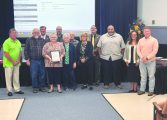By Heather Michon
Correspondent
Supervisors and members of the Planning Commission held a joint work session Wednesday night (June 5) as part of their ongoing discussion on how to manage the development of solar power projects in Fluvanna County.
By the end of the two-hour session, the group felt far more knowledgeable about both the potential impacts of solar and the tools they have at their disposal as they work to craft updated ordinances regulating solar development.
Supervisor Tony O’Brien (Rivanna), who sits on the subcommittee that will soon offer recommendations to the board on potential ordinance changes, said “I really wish we’d had this meeting before we did that because there is so much information that we’ve learned here.”
Rather than focus on the pros and cons of solar power, the presenters shared their insights into how the industry is developing and what local governments can do to manage it,
Todd Flowers, director of Business Development for Dominion Energy, said most solar projects take 3-5 years of work before a shovel ever hits the ground.
The first phase involves identifying a site, working with landowners to buy or lease the land, conducting studies, meeting with stakeholders and local officials to work out the details of the project, getting approvals from multiple regulatory groups, and obtaining permits from the localities.
Assuming they get to the end of that process, building the solar arrays usually takes 12-24 months to complete.
Then, the property will sit there, quietly generating energy for around 35 years.
Solar is still a relatively new industry, and Flowers admitted that they are still working on issues like power storage, stormwater management, and vegetative buffers.
Since most current solar fields are still a decade or more away from decommissioning, there isn’t even an industry for recycling old solar panels.
However, the general feeling was that all of these questions have answers, and local governments can use those answers to develop best practices.
John Ingosh, a representative of the Virginia Cooperative Extension, shared some of the insights from a new study on the potential impact of solar fields on agricultural soils.
One big question about converting farms to solar is whether or not more than three decades of sitting untouched will revitalize the soil and potentially be re-converted to more productive farmland.
Ingosh said the study found that practices that minimized heavy soil disruption had the best long-term results. Stripping off the topsoil and exposing the subsoil had the worst impacts.
Katelyn Jordan of the Virginia Farm Bureau said her organization’s position is that solar should be restricted to already unproductive land like brownfields, landfills, and reclaimed mining sites.
They believe that acreage designated as prime farmland should be closed to solar development.
In Fluvanna, which has nearly 50,000 acres of prime farmland, that would restrict most of the land east of Rt. 15.
Jordan challenged members to address land use issues head-on “and ensure that in the race to power Virginia, we don’t leave her hungry.”
Work on creating ordinance changes will continue for the next several months, and no action will be taken on pending solar projects until at least October.
Other matters:
Before the work session, supervisors made several new committee appointments.
Planning Commissioners Barry Bibb (Cunningham) and Howard Lagomarsino (Palmyra) were appointed for new terms.
Charlotte Gregory was appointed to the Economic Development Authority, James Schoenster was appointed to the JAUNT Board, Cheryl Potter was appointed to the Library Board of Trustees, and Chris Baca was appointed to MACAA.
The board also approved the advertisement of public hearings in July.
One hearing will focus on a proposal to increase the fees for erosion and sediment control assessments by the Planning Department.
Also up for discussion is a waiver for the Mountain Hill subdivision, a proposal by the Fluvanna-Louisa Housing Foundation to build 17 small, affordable homes for those 55+ or disabled. The site plan does not meet open space or housing density requirement and would need a waiver to proceed.




